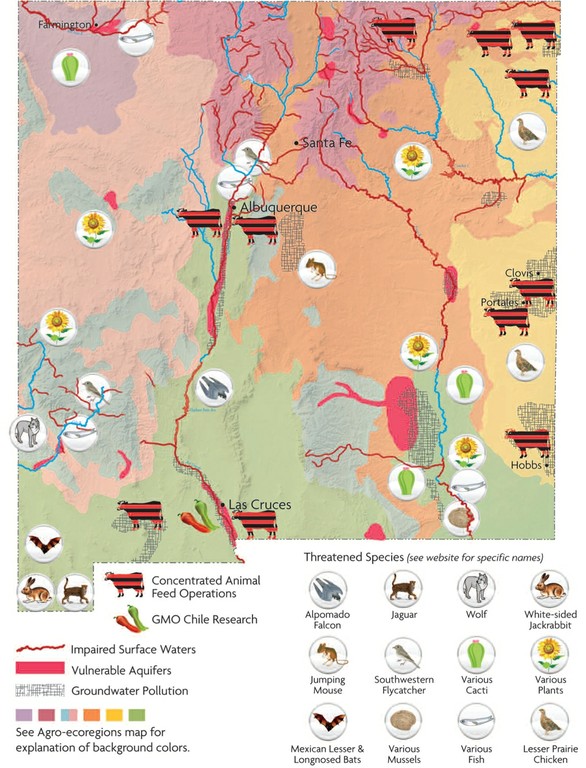Overview
Although exact numbers are difficult to come by, New Mexico has between 50 to 65 million acres of working landscapes: more than 400,000 acres in field crops for all types of hay and feed grains; about 80,000 in edible crops; and the rest in grazing on private, State, federal and tribal lands. In addition, abandoned range and cropland acres have never been surveyed. To fulfill one long-term dream of food security, the water sources and fertility of the soils of these agricultural lands must be maintained and regenerated. How do you keep up both production and ecological health of land, waters and life that have been hurt by past and present practices?
Eco-friendly agriculture, which preserves as much soil, water and biodiversity as possible with as few harmful side-effects as possible, plays a crucial role in long-term food security. There are numerous barriers to eco-friendly agriculture: species hurt by the water diversions and land clearing; dairy and feedlot pollution; predator-management; harms to human health; invasive pathogens, pests, animals and plants. Over 18 species, especially fish and riparian obligates, have been threatened by low flows. Farming has contributed to habitat loss of about 8 endangered plants. The dream for a human and eco-friendly dairy and beef industry is a difficult long-term task. Dairy ammonia and hydrogen sulfide exacerbate eye, nose and throat irritations.In addition, climate change, regulatory pressures, older operators, increasingly diverse operator goals and poorer economic returns have made farm and ranch ecosystem management challenging.
The most demanding dream that emerged in DNM’s project was how to compensate ranchers and farmers for eco-services. Ecological services include: carbon- sequestration; regenerating top soil; providing habitat for sensitive species; providing cover/ food/water for wildlife and game (especially wetlands and riparian habitats); increasing pollinators; stopping erosion; reducing harmful floods and invasive species; protecting endangered species; restoring fire regimes; removing toxics from nutrient cycles; and more. Many ranchers and farmers were happy to perform these tasks with some help for labor and equipment. They had no profit motive. Others sought eco-service management as a source of income.
The livestock industry has special needs to maintain long-term viability. Livestock industry dreams include ranchers manage herds to co-exist with predators, receiving payment for ecosystem services; confined animal operations (CAFOs) for beef and dairy cows radically limit and remediate their groundwater pollution; livestock nutrition minimizes greenhouse gasses; and CAFOs limit dust and bio-aerosols that cause asthma, and worsen respiratory diseases and allergies. Many citizens dream of a more humane treatment of livestock and fewer bovine growth hormones and anti-biotics. Grass-fed and natural beef focus these dreams.
Map: Eco-Friendly Agriculture

Download Eco-Friendly Agriculture map
In the dream, farms and ranches are a form of specialized ecosystem management. The map illustrates challenges to agricultural ecosystem management that have harmed the environment: impaired surface water include waters with excess nutrients, herbicides and salinity; vulnerable aquifers are losing their usefulness because water extraction exceeds water replenishment and/or the waters pumped have poor qualities; groundwater pollution comes from seepage of fertilizers and other agro-chemicals into the water table; concentrated animal feeding operations have many issues of public health, environmental pollution (aerosols, wastewater), animal welfare and occupational safety; genetically engineered chiles are opposed by growers of traditional landraces; and threatened species all have conflicts with some aspect of cattle raising, farmland clearing or practices.
Each agro-ecoregion has different invasive and sensitive species concerns. The Transition Mountain area of the Gila focuses on wolves and cattle-raising. Each river system has a different species of fish threatened by low flows and different aquatic plants have invaded each river (e.g., the Pecos has been overtaken by the invasive salt cedar). The rangelands all have invasive weeds and grasses that reduce forage values (e.g. Lehmenn’s lovegrass in the arid lowlands).
